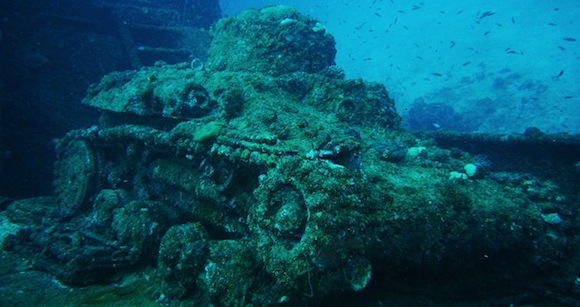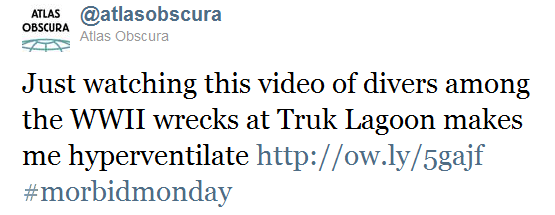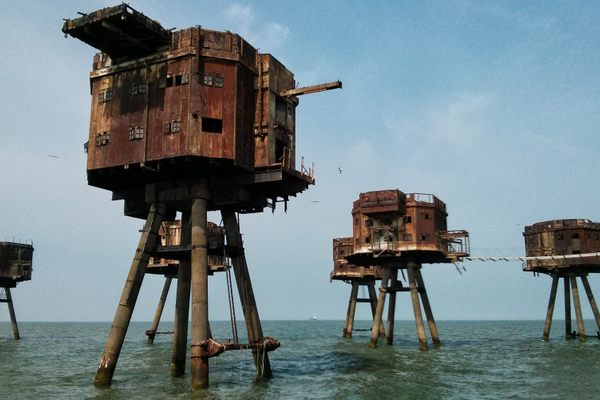Morbid Monday: Shipwrecks & Disasters at Sea

Today’s Morbid Monday shipwreck theme turned out to be a bonanza of strange and unsettling stories (Rhinos! Sharks! Operas for Dogs!), most of which did not inspire us to embark on sea adventures, to be honest. One of them was particularly haunting:

The clear and shallow waters surrounding the tropical Caroline Islands of Palau, Micronesia are littered with sunken ships, warplanes, and tanks.
On February 17, 1944 the Allies attacked the Japanese Imperial Fleet at Truk Lagoon. Just days before the Japanese had reinforced their numbers, so that when Operation Hailstone rained down bombs approximately 250 aircraft were destroyed and more than 50 ships sunk. Despite the scale of devastation, the wrecks, and the hundreds of bodies contained therein were essentially forgotten after WWII. It was not until Jacques Cousteau arrived in 1969 and found a graveyard amongst the ships that repatriation of the remains began. Today most of the bodies are gone, although a few stubbornly refused to leave, tucked into awkward crevices or trapped by marine life that had grown up over the decades.
Today the lagoon, now known as Chuuk, is a popular and accessible dive site (assuming you are in Micronesia, that is), and the most extensive WWII wreck site in the world. (Photo Source)
More on the Ghost Fleet of Truk Lagoon
Lose a few hours with these shipwreck related finds:
Interactive maps of shipwreck locations: Atlantic Pacific
Machine Project’s “Tragedy on the Sea Nymph”, an operetta by dogs, for dogs.
Dürer’s rhino drowned while chained to the deck of a sinking ship, immortalized in art
Why Lake Superior never gives up her dead despite 50 shipwrecks & counting
100 year old shipwreck still accessible on the Oregon Coast
This small Irish village suffered the greatest loss of life when the Titanic sank in 1912
The sinking of the Andrea Doria in 1956 more or less spelled the end of the era of luxury liners
The World Discoverer may just be the most impressive non-sunken shipwreck in the world
The terrifying story of the USS Indianapolis
Join us each Monday on Twitter and follow our #morbidmonday hashtag, for new odd and macabre themes each week: Atlas Obscura on Twitter
Previously:
Morbid Monday: Chung Ling Soo & the Bullet Trick That Went Horribly Wrong
Morbid Monday: Clemente Susini and his Anatomical Venus




















Follow us on Twitter to get the latest on the world's hidden wonders.
Like us on Facebook to get the latest on the world's hidden wonders.
Follow us on Twitter Like us on Facebook